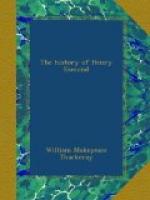On one of these many coward’s errands then, (for, as I view them now, I can call them no less,) Mr. Holt had come to my lord at Castlewood, proposing some infallible plan for the Prince of Orange’s destruction, in which my Lord Viscount, loyalist as he was, had indignantly refused to join. As far as Mr. Esmond could gather from his dying words, Holt came to my lord with a plan of insurrection, and offer of the renewal, in his person, of that marquis’s title which King James had conferred on the preceding viscount; and on refusal of this bribe, a threat was made, on Holt’s part, to upset my Lord Viscount’s claim to his estate and title of Castlewood altogether. To back this astounding piece of intelligence, of which Henry Esmond’s patron now had the first light, Holt came armed with the late lord’s dying declaration, after the affair of the Boyne, at Trim, in Ireland, made both to the Irish priest and a French ecclesiastic of Holt’s order, that was with King James’s army. Holt showed, or pretended to show, the marriage certificate of the late Viscount Esmond with my mother, in the city of Brussels, in the year 1677, when the viscount, then Thomas Esmond, was serving with the English army in Flanders; he could show, he said, that this Gertrude, deserted by her husband long since, was alive, and a professed nun in the year 1685, at Brussels, in which year Thomas Esmond married his uncle’s daughter, Isabella, now called Viscountess Dowager of Castlewood; and leaving him, for twelve hours, to consider this astounding news (so the poor dying lord said), disappeared with his papers in the mysterious way in which he came. Esmond knew how, well enough: by that window from which he had seen the Father issue:—but there was no need to explain to my poor lord, only to gather from his parting lips the words which he would soon be able to utter no more.
Ere the twelve hours were over, Holt himself was a prisoner, implicated in Sir John Fenwick’s conspiracy, and locked up at Hexton first, whence he was transferred to the Tower; leaving the poor Lord Viscount, who was not aware of the others being taken, in daily apprehension of his return, when (as my Lord Castlewood declared, calling God to witness, and with tears in his dying eyes) it had been his intention at once to give up his estate and his title to their proper owner, and to retire to his own house at Walcote with his family. “And would to God I had done it,” the poor lord said. “I would not be here now, wounded to death, a miserable, stricken man!”




